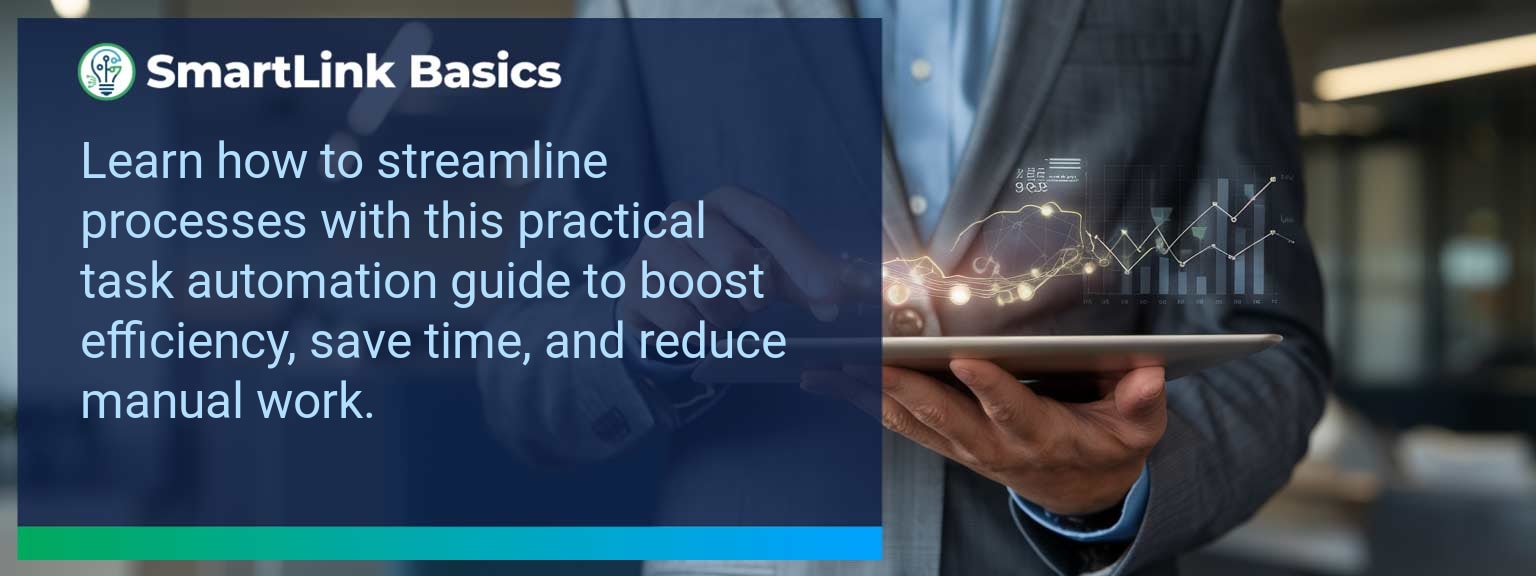Task Automation Guide: How To Transition Your Workflow From Manual To Automatic
Manual processes drain valuable sales time, slow decision cycles, and raise the risk of costly errors. Research from McKinsey shows that up to 45% of today’s paid work activities could be automated with existing technology. For sales leaders, this reality is an opportunity to redirect human effort from routine tasks to revenue-generating activity. SmartLink Basics works with organizations to make this shift deliberate and sustainable. This task automation guide explains how to evaluate your current workflow, address manual bottlenecks, and implement automation tools that improve efficiency and ROI. By the end, you’ll have a clear, structured path to migrate from manual systems to a scalable, automated operating model that aligns with your sales strategy.- Audit existing workflows and identify repetitive tasks
- Select automation software aligned with business goals
- Redesign processes for streamlined data flow and decision-making
- Train teams on new tools to ensure adoption
- Measure efficiency gains through defined metrics
What Changed And Why Task Automation Guide Matters Now
The rise of AI-powered sales tools and low-code platforms allows almost any organization to automate repetitive workflows. Manual processes—like updating CRMs, generating reports, and triggering follow-up emails—waste hours weekly. High-growth teams that implement workflow automation free bandwidth for complex client interactions. For example, automating lead distribution can reallocate hours each week to prospecting and deal strategy. To remain competitive, leaders must see automation not as a technology project but as a revenue enabler.Redesign The Revenue Operating System With Task Automation Guide
Optimizing automation begins with a deliberate redesign of the sales operating model. Four critical components shape sustainable gains.ICP, Segmentation, and Targeting Automating CRM tagging and lead routing ensures high-fit prospects get faster attention. For instance, AI scoring can prioritize enterprise over SMB accounts without manual filtering. Pipeline Architecture Integrating automation into your pipeline stages standardizes data capture and forecast accuracy. Automated alerts when deals stall help managers intervene earlier. Plays and Messaging Trigger-based email sequences can launch when prospects take defined actions, ensuring timely, relevant communication at scale. Operating Cadence Automated dashboards replace manual spreadsheet updates, enabling faster sales meetings with live data. The shift improves decision quality and speed.Common Problems With Manual Workflows
Manual workflows often create hidden costs. Inconsistent data entry produces unreliable reporting. Reliance on individual memory slows handoffs between teams. Without automation, scaling processes becomes risky and expensive. A sales leader managing a rapidly growing client portfolio may find that manual onboarding fails to meet SLA commitments. Addressing these risks early safeguards growth. Actionable insight: Document each workflow step and identify decision points that do not require human judgment—these are prime automation targets.Steps To Implement Effective Automation
Start by mapping existing processes and isolating repetitive, rules-based tasks. Explore automation software that integrates with current systems. Align tool selection with defined goals, whether that’s shortening sales cycles or improving time management. For example, a sales team might automate proposal generation based on client profile data, cutting preparation time from two days to two hours. Launch automation gradually, measuring adoption and performance impact before expanding.Benefits Achieved From Automation
When implemented effectively, workflow automation accelerates deal velocity, improves forecasting, and reduces operational costs. Teams gain transparency into sales performance without constant manual updates. One company saw a 30% reduction in quote turnaround time after automating document creation. Key takeaway: Measurable benefits compound over time as automation allows more focus on high-value sales activities.Emerging Trends In Workflow Automation
Generative AI is now enabling more complex automation, such as personalized outbound campaigns at scale. API-first platforms allow seamless integration of disparate tools, removing bottlenecks in cross-departmental workflows. Leaders who monitor these trends can implement competitive enhancements early, leveraging real-time data for faster strategic decisions. Access more AI-driven sales enablement resources from SmartLink Basics for strategic alignment.Metrics That Matter
| Category | Metric | Definition | Target |
|---|---|---|---|
| Leading | Automation Adoption Rate | Percentage of workflows transitioned from manual to automated | 80% in 12 months |
| Lagging | Cycle Time Reduction | Decrease in time from lead to deal closure | 20% improvement |
| Quality | Data Accuracy Rate | Proportion of CRM records without manual entry errors | 95%+ |
Get the 90-day plan, coaching rubric, and dashboard template to operationalize AI in your enablement program.









